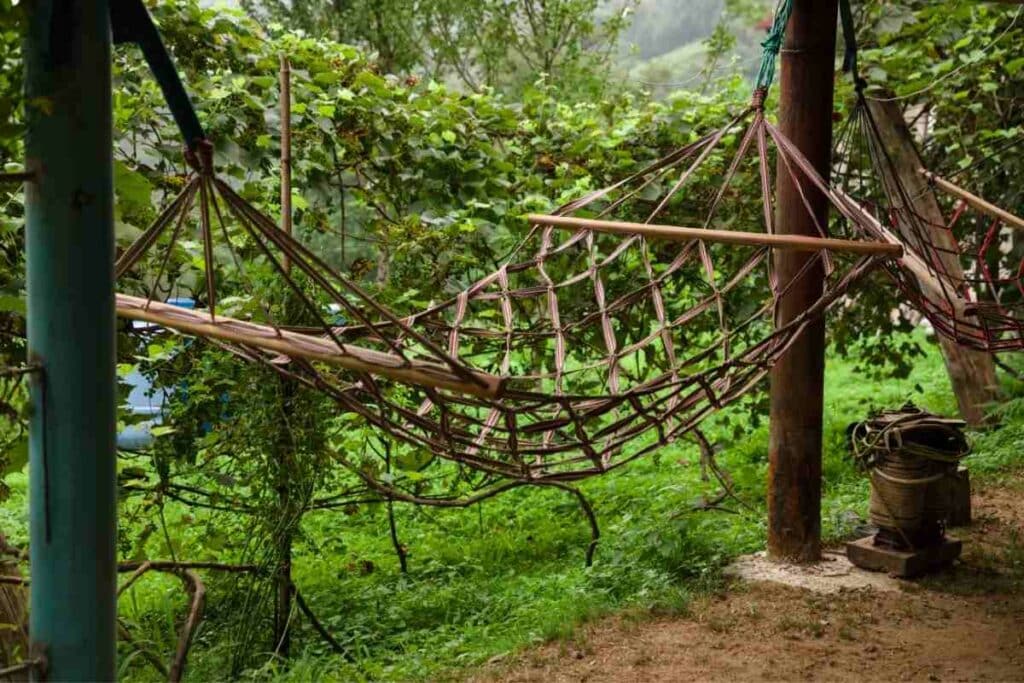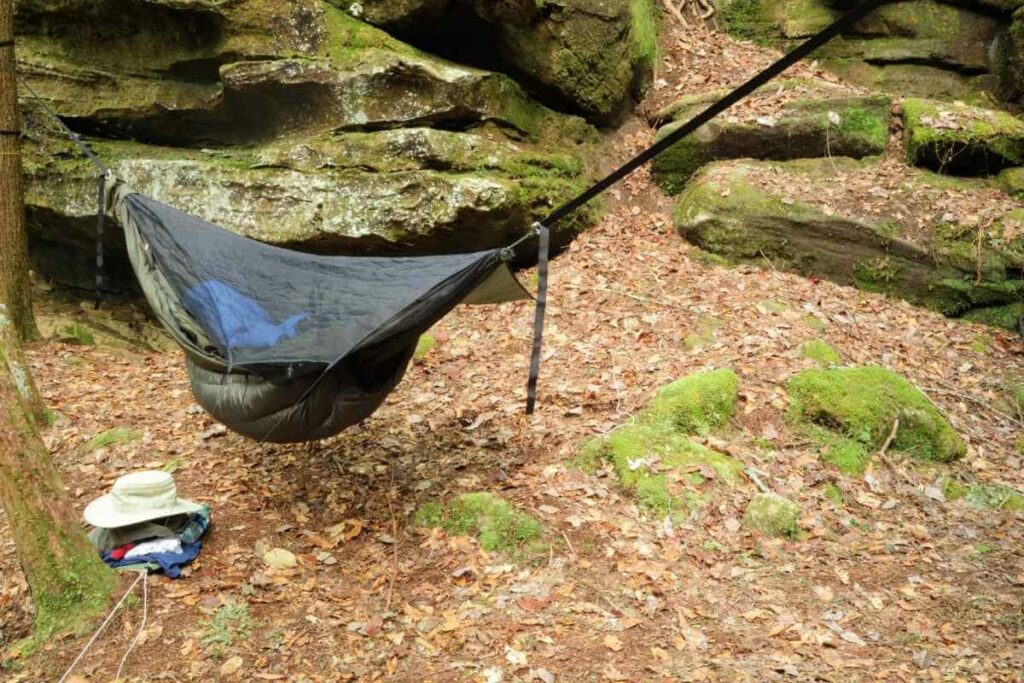Most people who have hammocks in their homes hang them between trees. However, the use of the structures isn’t limited to your home.
You might find yourself in a camping site without trees to suspend the hammock. When that happens, you need to get creative.
As improbable as it seems, it isn’t entirely impossible to hang a hammock without trees.
Luckily, several alternatives to trees can provide adequate support and ensure that you sleep comfortably and safely.
These include wooden posts, rocks, DIY stands, and so on. You can also use your car as an anchor.
Read on to discover some of the items you can use to hang your hammock without trees.
8 Ways To Hang A Hammock Without Trees
Use Hammock Stands
If you’re camping by the roadside, hammock stands provide a convenient option for suspending your hammock.
These stands are easily accessible, as you can purchase from most outdoor gear stores.
Hammock stands are handy for camping because of their collapsible and lightweight design.
As such, you can fold them after use, and they won’t take up much space in your traveling bag.
Additionally, the stands are easy to set up.
They also come with a chain and strap where you can attach your hammock.
Use Your Vehicle

Do you know that you can use your car as an anchor for hanging your hammock?
If you find yourself stranded in a campsite without trees, attach one side of your hammock to a vehicle and the other to a post. (If you have two cars, you won’t need the pole).
When attaching the hammock to the car, strap it to a solid place that won’t get damaged by your body weight when you start sleeping.
Remember This: It’s also important to ensure that the pole on the other side is deep enough into the ground so that it doesn’t slip.
Use Poles

Poles are a cheaper alternative for those who can’t afford hammock stands.
Moreover, they are available in different types, from trekking poles to wooden poles.
Regardless of your preferences, use poles that can support your body weight without breaking.
When using poles to support your hammock, ensure that the distance between them is enough to support its length.
More importantly, dig holes that have adequate depth to hold the poles sturdy.
You don’t always have to set up the poles yourself.
If you’re camping in an area with telephone poles or old fence posts, you can use them to hang your hammock.
That said, you should never hang your hammock on an electricity pole.
Use Buildings

You can also use outdoor structures to hang your hammock, such as
- pavilions
- shelters
- and sides of buildings
Most of these are accessible in public campsites and state parks.
Similar to using your car, you’ll need a supporting pole on one side to hang your hammock.
However, you’ll need to be extremely careful when attaching hammocks to the building because it requires robust hooks to tie to the cords.
Use Rocks

For those who do rock climbing, this is an intelligent way of hanging your hammock.
If you already have support on end, look for a huge rock to support the other.
Find a crack or any deep crevice in the rocks to attach a nail or peg.
If you can’t find one, use carabiner and or pitons. Then, attach the straps from your hammock to the anchor, nail, or pegs.
Works Best: It’s advisable to look for rocks at least 10 feet apart and large enough to support your body weight. Regarding height, it should range between six and eight feet.
Build a Hammock Structure

A permanent solution to your hammocking problems at home is by constructing a hammock structure.
You can choose to go the DIY route or build a full-on weatherproof outdoor sleeping area.
Your preferences and budget determine the size of the hammock structure you build.
You can use online resources to find some inspiration on how to make one yourself.
Most designs follow the concept of making hammocking anchors using posts.
However, building a fully-fledged structure allows you to fine-tune your design and preferences.
Use Your Hammock as a Tarp
You can always use your hammock as a tarp when everything else seems impractical.
Most of the hammocks sold in outdoor gear stores are made using water-resistant materials, ensuring that you’re well protected from adverse weather conditions.
Here, you hang your hammock as you would if you own a tarp.
If you don’t have rocks:
- consider using poles
- or anchoring them to a car or a nearby building
One option is to pitch your hammock on poles spaced 10 feet apart and use guy lines to ensure it doesn’t slip during use.
Hang Your Hammock Indoors
Although it’s primarily intended for outdoor use, you can hang hammocks indoors to add a unique relaxation space in your home.
The same hardware you use to anchor your hammock outdoors can be used to pitch your hammock on the walls or support it from the ceiling.
Start by drilling holes where you’ll put attaching hooks.
Then, screw in bolts and attach hooks that will support your hammock.
Amazing Hammocks on Amazon
Secrets to Hanging a Hammock without Trees
When choosing alternatives to a tree to offer support for your hammock, you must consider the following factors.
1) Identify an Ideal Spot
It’s vital to assess the suitability of a location before setting up your hammock without trees.
Ensure that the place you choose isn’t rocky, as this increases the risk of injury if you fall off your hammock.
You might have a first aid kit, but you should take every possible measure to prevent you from using it.
Ideally: The place you choose should be clean and plain. If you can’t find one, ensure that you start by cleaning.
2) Choose the Required Distance
Most hammocks can stretch for 18 feet, but you can comfortably reduce the distance to as little as 10 feet.
This consideration is essential when choosing the support structure for your hammock.
It also helps you know if you need additional ropes and straps to pitch your hammock if the selected space is wider than the recommended range.
If you intend to keep your hammock stand in the same spot:
- Use the maximum possible distance. This gives you flexibility should you decide to purchase a bigger hammock in the future.
- Alternatively, you can invest in adjustable stands that enable you to modify the length of the base depending on the stretch of your hammock.
3) Meet the Ideal Height
As mentioned above, hammocks are stretchy.
This means that you need to ensure that your hammock has sufficient height allowance before jumping onto it.

This guarantees safety when the hammock stretches due to your body weight.
Avoid hanging your hammock too high, as this increases the chances of severe injury if you fall from the hammock.
For most people, the preferred height is four feet. That said, you can raise or lower it a bit, depending on your height.
Try different levels to determine the one that suits you best before you relax on your hammock.
For Optimal Comfort: Place your hammock four feet higher than your height if you’re under 5’9”. If you are 5’10” or taller, increase the height to 4.5 feet.
4) Choose Your Preferred Hanging Method
Despite the popularity of ropes for tying hammocks, they are not as secure as straps.
Also, ropes are harder to set up.
For more safety and increased convenience, use straps instead of ropes.
Straps have loops that enable you to adjust the height and distance to your preferred comfort levels.
The adjustability of straps also ensures that you don’t exert too much pressure on the anchor and suspension points.
Whenever you decide to hang your hammock without trees, maintain an angle of 30o between the straps and suspension points.
5) Secure the Anchor Points
Nothing is as disappointing and potentially dangerous as falling from your hammock.
The best way of preventing such incidences is by securing the anchor points before you get comfortable.
Consider testing the anchor points several times, as well as the integrity of the ropes and straps supporting your hammock.
More Importantly: ensure that the structure can support your body weight.
How to Build a DIY Hammock Stand
If you like building things, you can make a DIY hammock stand.

The process is simple and inexpensive, and more importantly, it gives you a sense of accomplishment once you complete the project.
Materials
Here are the materials you need to acquire before you start constructing a hammock stand:
- ½” spade bit
- A drill press
- Two pressure-treated posts
- Eyebolts with washers
- Steel carabiner clips with locking bolts
- Pre-packaged concrete
- Water
- Posthole digger
- Waterproofing agent
Procedure
Follow these steps when constructing a DIY hammock stands:
- Apply the waterproofing agent to the hammock posts.
- Use the spade bit to drill a hole for the eye bolt. This hole connects the hammock to the post.
- Use the post hole digger to dig holes. Make sure that the holes are deep enough to accommodate 30% of the poles’ length. This is meant to provide adequate support for the hammock when you lay on it.
- After placing the posts in the holes, add the pre-packaged concrete according to the manufacturer’s instructions. It usually takes two days for the concrete to dry, after which you should cover the hole with dirt.
- Your hammock stand is now ready for use.
Additional Tips for DIY Hammock Stands
After assembling your hammock stand, you’ll want to make it more welcoming by working on the condition of your outdoor space.
For instance:
- You can plant grass and do landscaping to breathe more life into your backyard.
- You can also install a side table where you can place a drink as you swing on your hammock.
- Furthermore, it would be best if you constructed your shade as close to a shade as possible.
After all, nobody wants to relax under scorching sunlight.

Always ensure that you have extra accessories for your hammock, whether at home or on a camping trip.
It’s helpful to keep spare hooks, ropes, and straps.
This way, you won’t cut short your relaxation in case one of these fails.
Hammock Stands – Frequently Asked Questions
Here are some frequently asked questions regarding hammock stands.
What is the Best Type of Hammock Stand?
Although this comes down to your preferences, the best type of hammock is one that guarantees comfort and safety during use.
The stand should also complement your home décor so that it doesn’t look out of place.
How do I Choose a Hammock Stand?
After identifying a perfect location, check the safety features offered by the stand.
Then, look at additional factors like the material used, style, and the finish.
Always go a stand made using weather-resistant materials since you’ll be using it outdoors.
What about Size?
The size of the hammock stand you need depends on your body weight and the length of the hammock itself.
For instance, you’ll require a large frame if you intend to use a hammock that carries two people.
What is the Capacity of a Hammock Stand?
The capacity of a typical hammock stands ranges between 250 and 800 pounds, depending on the size and material used in its construction.
Double hammock stands can comfortably support more than 1,000 pounds.
Final Words
By now, you are an expert at hanging hammocks without trees.
This means that you can comfortably set up a relaxing space anywhere, even if there’s no vegetation.
Always prioritize your safety when hanging your hammocks. The ropes, straps, and hooks you use must come from reputable manufacturers.
The same applies to the support mechanism – whether it’s a pole, your car’s chassis, a building, or rocks, ensure that it is strong enough to withstand the tension applied by your body weight.
Lastly, avoid setting up your hammock in rocky terrain, which increases injury severity if an accident occurs. Don’t forget to carry a first aid kit on every camping trip.
